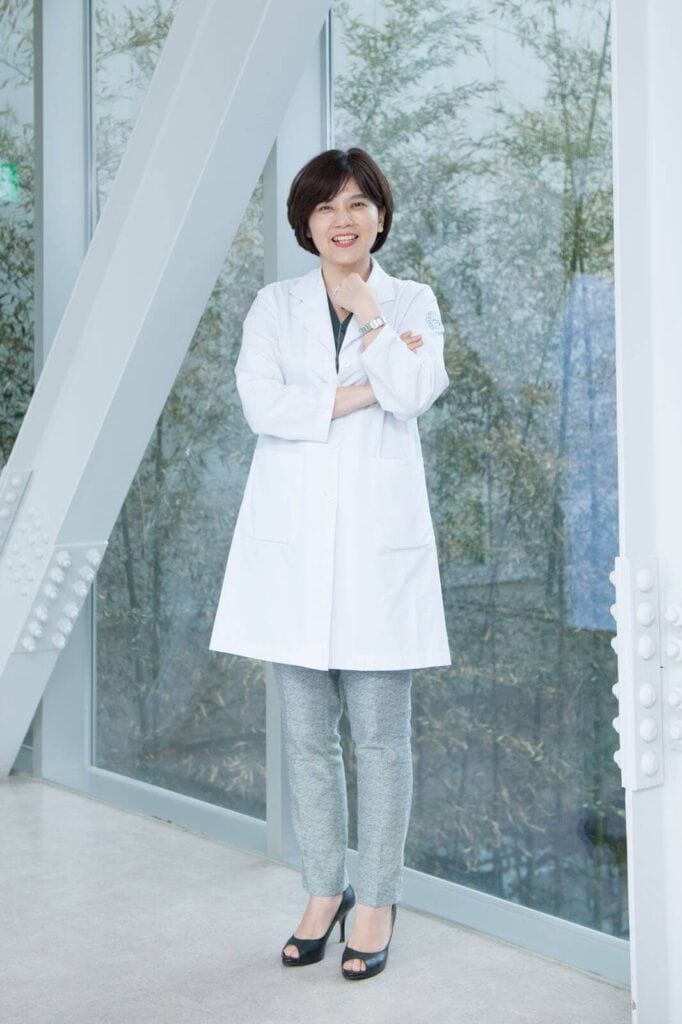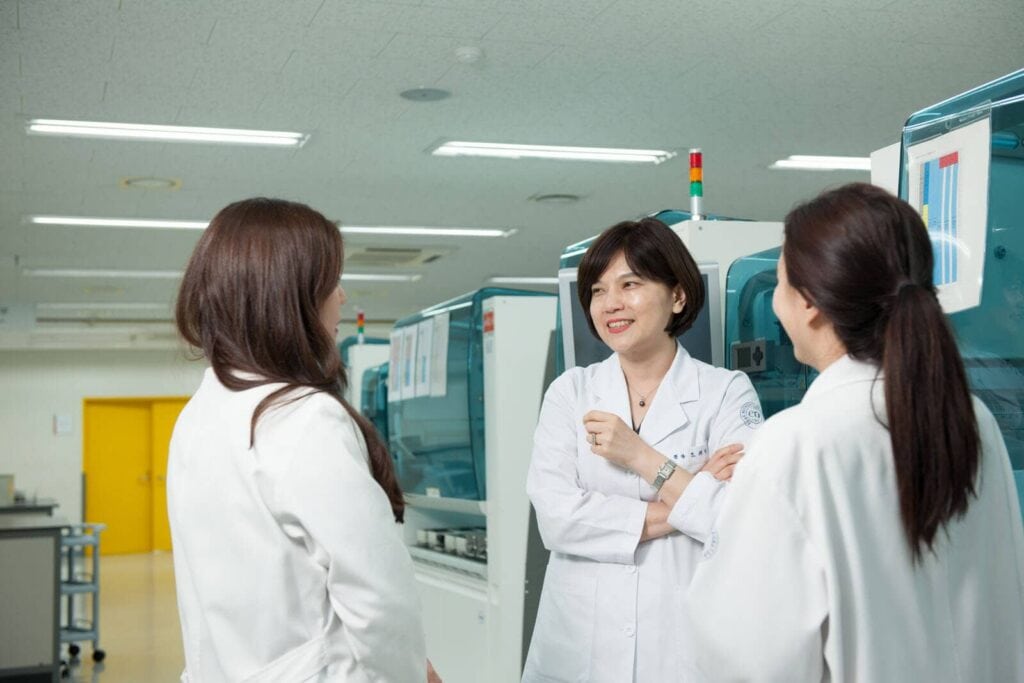
Dr Gwi-young Oh is the Laboratory Director of EONE Laboratories, a large reference laboratory in Song Do, Incheon and the first commercial laboratory to introduce radio-immunoassay testing in South Korea. In this interview with Roche Diagram, Dr Oh looks at the evolution of laboratory medicine in South Korea and the exciting developments ahead.
Dr Gwi-young Oh’s love for all things science and mathematics, coupled with a desire to understand the principle behind how things work, led her to medical school. Still, she felt something was incomplete. When she attended a class on laboratory medicine in her second year of medical school, she realised that this was the path that she was meant to take. She has never looked back since. “It is one of the best decisions, career-wise, that I have ever made,” she says. “The field of laboratory medicine is the right fit for my interests and personality. No two days are alike. You learn something new, gain a fresh perspective and are constantly challenged to keep up with the pace of change.” She has seen how the field has grown throughout her career, and shares her views on the key changes that have impacted the industry.
Universal Healthcare: Paving the Way for Efficient Healthcare Delivery
South Korea established universal health coverage in 1989, 12 years after the introduction of mandatory health insurance for employees in large corporations. With this, timely diagnosis and quality care became the cornerstones of the Korean healthcare system. Diagnostics outcomes today are advancing beyond measuring technical performance (accuracy, sensitivity, specificity), and shifting to providing hard evidence of benefits to patients and savings that are quantifiable by country and by region. This is why, says Dr Oh, that unlike many countries where cost is considered a major key performance indicator (KPI) for a laboratory, in South Korea which has an advanced healthcare system, efficiency and turnaround time (TAT) are of paramount importance.
“Laboratories in South Korea work with high volumes so our focus has consistently been on automation and consolidation. The industry is growing tremendously and while this presents a number of challenges, it also puts pressure on the laboratory staff. Ultimately, if the laboratory cannot handle all the samples within the expected timeframe, it results in a delayed TAT,” said Dr Oh.
“So growth at the cost of efficiency is not a sound approach,” continued Dr Oh. “Laboratories need to consider solutions that would help them increase capacity to meet the growing demands, whilst improving efficiency by reducing TAT.”
“With an ageing population and rising incidence of chronic diseases, the volumes in the lab will continue to increase. Moreover, for smaller clinics and hospitals it doesn’t make business sense to invest in analysers so they rely on reference laboratories like ours,” she stated.
To meet the rising demand, in 2013, EONE installed a track system that enables the connection of pre-analytical systems with analysers. This helps to automate sample transportation and guarantee a predictable TAT, while still retaining the advantages of a stand-alone automation system such as high throughput and flexibility.
Currently, EONE processes more than 600,000 blood samples and over four million tests per month with a comprehensive test menu of more than 3,000 tests. Test results are provided quickly and precisely by dedicated teams who focus on clinical chemistry, immunochemistry, urine chemistry, cytogenetic and cytopathology.

Investing in people and technology
Another evolution that the industry is going through is related to the adoption of new technologies. Dr Oh said it’s important to have an open mind. “There needs to be an understanding that a higher cost will be involved, staff will need to be trained to operate new technologies along with the understanding that it will take some time for these new technologies to break even.” However, new tests and technologies are to be contextualised so that they do not cause confusion. This requires the laboratory professionals to take on the role of a navigator and get more involved with clinicians on the interpretation of a result. Increased levels of automation provide an opportunity for laboratories to evolve from their role of ‘service provider’ to that of central player who drives maximum patient care value through the efficient, accurate and timely deployment of testing.
So, a laboratory technician needs to have a versatile set of skills. These range from administration and cost management to areas such as data analytics, as well as sales and marketing. “A good understanding of industry trends and developments in reimbursement and technology are a definite plus,” said Dr Oh.
In the past, Dr Oh explains, the laboratory professionals had limited scope. “The laboratory was not seen as an integral part of healthcare delivery. The job entailed doing routine tests and dispatching results.” But, it’s an entirely different ball game today.
“Laboratory science involves diagnostic laboratory testing from A to Z. Laboratory professionals do everything from providing cancer test results, to advising on the correct drug to prescribe, to determining treatment options as part of a multi-disciplinary care team.”
The question now is how can we enrich individual lab results with algorithms that combine various test results with real world data to provide more actionable information for clinicians.
Dr Oh credits the Academic Association for Lab Medicine in making significant strides to diversify the path in laboratory medicine for talents who are looking to explore this field. “We need to see more role models in the field of laboratory medicine, who can deliver the message to the younger generation that there is a career in laboratory medicine,” Dr Oh said.
EONE invests in the learning and development of its employees. Every month, the lab holds an internal conference to provide education and training for all staff. Additionally, staff who have clocked in a number of years of service, and who display great potential, are sent for overseas conferences to further enhance their knowledge.
Harnessing the power of the future
Predicting the next big changes in the field of laboratory medicine, Dr Oh cites genomics and artificial intelligence (AI) as game-changers. As genetic testing becomes more sophisticated, Dr Oh sees this leading to the development of preventative medicine, while AI will be able to lead to cases being sorted into a more accurate database.
Betting big on a promising future, Dr Oh said, “Traditionally in laboratory medicine, we have been risk-averse preferring to stick to the tried-and-tested. But as the world around us changes, we need to upskill and upgrade to keep up and stay ahead of the curve. Take for instance, the amount of clinical data that is currently being generated in a laboratory each month. The question now is how can we enrich individual lab results with algorithms that combine various test results with real world data to provide more actionable information for clinicians.”
“These changes cannot happen overnight. In order to conduct tests in a more accurate way, we need to continue to make investments – in science, in diagnostics, and in people,” Dr Oh concludes.
Then & Now
In an American Journal of Clinical Pathology Special Report,1 Dr Desmond Burke stated: The enormous advances in science and technology that have characterised the 20th century have transformed the practice of clinical medicine dominated by the use of medical technology – in particular, laboratory testing. There is every reason to believe that this trend will continue into the 21st century.
Moreover, it will continue against a background of ongoing advances in information technology and computer-based electronic communications – advances that could revolutionise the provision of medical care. These changes are likely to have profound effects on the practice of laboratory medicine; effects that will be determined by the competing demands of cost containment, assurance of quality, and financial support of education and research.
After almost a century of enormously successful growth and development, laboratory medicine faces serious challenges.
Less clear is how the two traditions – academic laboratory medicine, with its emphasis on teaching and research, and clinical pathology, with strengths in test strategy and interpretation of results – will fare in an environment dominated by cost containment and a public increasingly concerned with avoidance of error and the assurance of quality.
The survival of both in such an environment depends on the ability to add value. That ability depends in turn on how effectively academic laboratory medicine and clinical pathology exploit advances in science and technology – particularly advances in computer-based electronic communications and information technology – to add value to the care of patients.
References:
¹Am J Clin Pathol 2000;114:841-846














